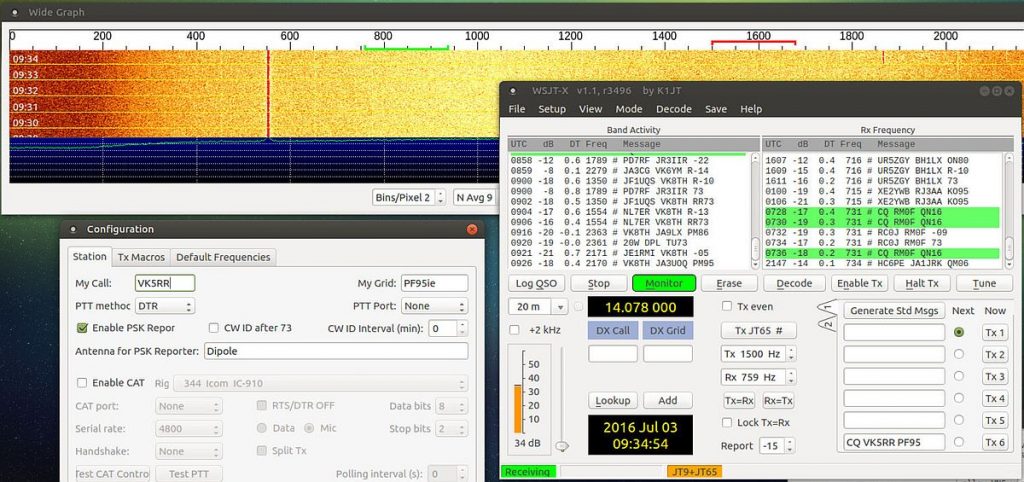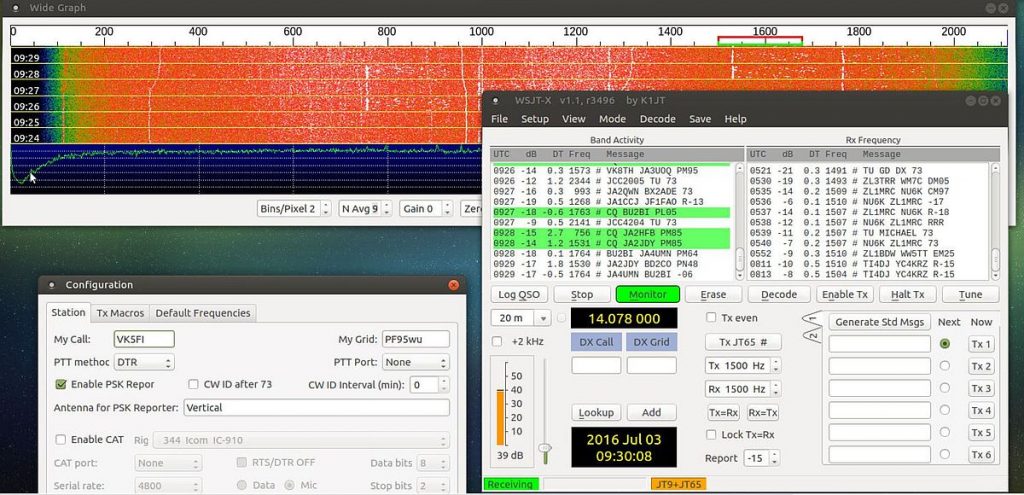Over the last several weeks we have been running an experiment – an experiment that is all about doing the same* (similar) thing at different locations.
We are fortunate enough to have more than a single QTH where we can set up an amateur station, so we have done so.
Station 1
We set up Station 1 at our Main home QTH in the City – in PF95ie
The station consists of the following
- Kenwood TS-2000 TXcvr
- Dipole at 11m high (running North/South)
- Pine64 Running Debian Mint and the current version of WSJT-X into a USB sound card.
Station 2
We set up Station 2 at our shack in the Riverland, approx 160km away in PF95wu This is a semi-rural location with less than 50 houses within 1km, but in an active irrigation farming area (think pumps switching all the time)
The station consists of the following
- Icom IC-706 (yep the 20+ year old original version)
- GAP Antenna Challenger DX Vertical
- Pine64 Running Debian Mint and the current version of WSJT-X into a USB sound card.
As you can see both stations are very modest – and what I would call Atypical of what someone might have installed. There is not a lot of differences between them – but, granted, there are differences.
We chose to do this experiment with JT65 simply because of the ease of setting it all up and having it automatically report the results. We could have probably done the same and set up a similar experiment with WSPR, but chose JT65 as you can actually have a “QSO” using this mode.
We wanted to set up the stations to reflect what would be reasonably easy for almost anyone to set up and have working with a minimum of fuss – just using whatever antenna you have and whatever TXCVR you have as well. Ah yeah, also, to put a couple of VK5 Callsigns in the reporter list so the rest of the world knows we exist 🙂
As a point of interest, we have had the Vertical antenna and the same dipole installed at Station 1 for several years, and never really had much luck with any contacts on the vertical – it was always a lot noisier in the city than the dipole. The only advantage it gave us was it is no tune, all band.
The Experiment
We set up both stations to operate 24/7 on 20m listening to JT65 segment of the band on 14.075USB, both Stations were tuned to show the same signals in the waterfall – so as not to distort what is being heard by each station. Both stations have the pre-amp on, bandpass filters set to 3khz, no noise blanking or filtering enabled.
Both stations are set up to report to PSK reporter so we could collect the data and analyse the results.
Station 1 is set up using the callsign VK5RR and station 2 is set up using the callsign VK5FI and they have both been running for a few weeks now, It did take a couple of weeks to get the 2 stations set up so that they were stable and pretty much on the same frequency
While we were setting up the baseline so we could see some results we were simply monitoring pskreporter and making a mental note of the results. Once we got to a point of seeing consistent results from both stations with them both up and reporting for more than 2 weeks, we have started grabbing some stats from PSK reporter and assembling them over the last few days.
The Results
Well, the experiment is ongoing, so results are simply a snapshot in time of our observations over the last few days.
As this experiment is ongoing, you can view the results in real-time yourself. follow the 2 links below, select Band, 20m, Mode JT and the desired time window.
| Station 1 | |||||||
|---|---|---|---|---|---|---|---|
| Date | Time UTC | 1 Hr | 2 Hr | 3 Hr | 6 Hr | Week | |
| 30/06/2016 | 2130 | 0 | 0 | 0 | 1 | 33 | |
| 01/07/2016 | 0130 | 6 | 9 | 15 | 16 | 34 | |
| 0300 | 3 | 8 | 11 | 18 | 34 | ||
| 0430 | 6 | 11 | 12 | 25 | 34 | ||
| 1200 | 0 | 0 | 19 | 50 | 35 | ||
| 02/07/2016 | 0000 | 6 | 14 | 28 | 30 | 29 | |
| 0200 | 9 | 15 | 17 | 37 | 30 | ||
| 0620 | 5 | 15 | 16 | 27 | 29 | ||
| 1230 | 1 | 1 | 4 | 23 | 29 | ||
| 1330 | 2 | 2 | 2 | 17 | 29 | ||
| 0130 | 7 | 10 | 20 | 28 | 30 | ||
| 0630 | 11 | 17 | 23 | 31 | 31 | ||
| 0930 | 6 | 21 | 24 | 45 | 32 |
| Station 2 | |||||||
|---|---|---|---|---|---|---|---|
| Date | Time UTC | 1 Hr | 2 Hr | 3 Hr | 6 Hr | Week | |
| 30/06/2016 | 2130 | 6 | 10 | 16 | 40 | 76 | |
| 01/07/2016 | 0130 | 19 | 49 | 69 | 99 | 76 | |
| 0300 | 21 | 35 | 59 | 113 | 77 | ||
| 0430 | 36 | 47 | 61 | 116 | 77 | ||
| 1200 | 0 | 0 | 35 | 108 | 77 | ||
| 02/07/2016 | 0000 | 35 | 54 | 78 | 115 | 74 | |
| 0200 | 21 | 43 | 69 | 118 | 76 | ||
| 0620 | 30 | 51 | 73 | 111 | 76 | ||
| 1230 | 6 | 12 | 17 | 88 | 76 | ||
| 1330 | 26 | 27 | 28 | 87 | 76 | ||
| 0130 | 22 | 42 | 64 | 78 | 80 | ||
| 0630 | 55 | 91 | 110 | 144 | 81 | ||
| 0930 | 21 | 53 | 79 | 168 | 82 |
Conclusions
Strictly speaking, since the experiments is still ongoing there are none – but simply some observations of the results that we are seeing.
- The 20m band (winter propagation) does shut down for significant portions of the day.
- There is significant differences in the observed results for each station
- Station 2 has much better “ears” than Station 1 – considering that our usage of the Vertical has been disappointing over the last several years
- City locations with the inherent HF noise floor (which is evident in the images above) are not such a good place if you are wanting to use HF.
- It is interesting to observe and note what time of day favours what part of the world – it is pretty easy to see when the band is opened to where in the world.
So, where to from here, that is easy, the next step will be to put up a dipole at station 2 and make observations over another week or 2 and see if this has a significant impact on what is being heard.
One thing for sure, we really need to spend a bit more time on our remote station and HF might just become one of those things that is not beyond reach.



We ran the experiment for a further 2 weeks and it was truly interesting to see an almost 3:1 ratio of reported stations – 3x as many reports from Station #2. The raw logs were also interesting to note with the station #2 logs being more than 5x the size of station #1 logs.
Hi.
could you please share the steps , how did you install WSJT-X on Pine64 OS
Thank you,
vu2upx